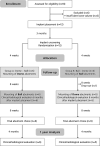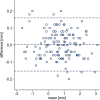Short strategic implants for mandibular removable partial dentures: One-year results from a pilot randomized crossover abutment type study
- PMID: 34352145
- PMCID: PMC9292160
- DOI: 10.1111/clr.13815
Short strategic implants for mandibular removable partial dentures: One-year results from a pilot randomized crossover abutment type study
Abstract
Objectives: The present pilot study analyzed two abutment types (a retentive ball and a non-retentive dome) in implant-assisted removable partial dentures (IARPDs) on 6 mm short implants with respect to clinical, radiological, and patient-reported outcomes (PROs), during the first year.
Materials and methods: Two implants were placed bilaterally in mandibular molar sites, converting existing free-end removable partial dentures (RPDs) to IARPDs. Twelve subjects were randomized to initially receive either the dome (Group A, n = 6) or the ball abutment (Group B, n = 6). After eight weeks, the abutments were exchanged. After another 8 weeks, the participants were given the choice of one of the abutments. Mean values and standard deviations (SD) were calculated, and random-effect linear regression analyses were applied to analyze marginal bone level alterations and PROs (α < .05).
Results: Twelve participants were included in the study; however, one dropout occurred. Patient ratings increased significantly in both study groups. The majority of the participants (82%) ultimately chose the ball abutment. The implant survival rate was 100%, and the success rate was 90.9% twelve months after implant placement (mean peri-implant bone-loss: -1.2; SD: 0.6 mm) without a statistically significant difference between the study groups, in terms of clinical- and radiological outcomes.
Conclusion: Placing 6 mm short implants at mandibular molar sites of RPD wearers seems to be a viable treatment option, based on this investigation with a short-term follow-up. Although only minor differences between the two abutments were observed, patients seem to prefer the ball over the dome abutment.
Keywords: OHRQoL; Short implant; abutment; anchor; bone-remodeling; implant overdenture; strategic implant.
© 2021 The Authors. Clinical Oral Implants Research published by John Wiley & Sons Ltd.
Conflict of interest statement
The authors report no conflict of interest.
Figures







References
-
- Al‐Nawas, B. , & Schiegnitz, E. (2014). Augmentation procedures using bone substitute materials or autogenous bone ‐ a systematic review and meta‐analysis. European Journal of Oral Implantology, 7, 219–234. - PubMed
-
- Astrand, P. , Engquist, B. , Dahlgren, S. , Engquist, E. , Feldmann, H. , & Gröndahl, K. (1999). Astra Tech and Brånemark System implants: A prospective 5‐year comparative study. Results after one year. Clinical Implant Dentistry and Related Research, 1, 17–26. 10.1111/j.1708-8208.1999.tb00087.x - DOI - PubMed
-
- Bassetti, R. G. , Mericske‐Stern, R. , & Enkling, N. (2016). Are there differences in the changes in oral‐health‐related quality of life (OHRQoL) depending on the type (rigidity) of prosthetic treatment? Quintessence International, 47, 749–757. - PubMed
Publication types
MeSH terms
Substances
Grants and funding
LinkOut - more resources
Full Text Sources
Miscellaneous

